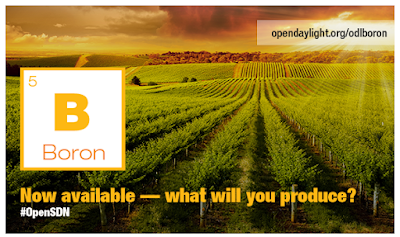The OpenDaylight Project announced its fifth open SDN release: OpenDaylight Boron, featuring significant enhancements to Cloud and NFV use-case capabilities, as well as to performance and tooling to simplify management of a range of use cases.

More than half of the new projects proposed came from user organizations, including:
- YangIDE, led by AT&T, provides support for building new YANG models
- Telefonica and Intel-led NetIDE, which makes it easier to share apps across controller deployments
- EMAN, led by Comcast, for improved energy efficiency for the network
- As deployments grow in scale and sophistication, end-users are increasingly looking to integrate OpenDaylight more deeply into their core architectural frameworks. One example of cross-industry collaborations is the Atrium Enterprise project which was led by the Open Networking Foundation with participation from Criterion Networks, WIPRO and Microsoft. Another example is ECOMP, from AT&T, an infrastructure delivery platform and scalable, comprehensive network cloud service for a software-centric network.
“We’re excited to see the release of OpenDaylight Boron,” said Chris Rice, SVP of Domain 2.0 Architecture and Design at AT&T. “We contributed to the release and expect to use the code at the heart of our network. We like OpenDaylight for the breadth of ‘brownfield’ protocols that are supported, its model driven approach that matches our service abstraction logic, and the ability to add applications on top of the controller base. One of the tenets of the open source community is that you don’t just take code. You contribute it, as well. We’re committed to doing just that, and this is an example.”
Enhancements in Boron include:
- OpenStack-related capabilities have been re-architected within a unified development framework for better scalability and performance, including clustering, High Availability (HA), and persistence.
- Southbound enhancements for VNFs include OpenFlow and NETCONF optimization, as well as hardware VTEP support, and DPDK enhancements.
- The NetVirt project brings new focus to features and performance to OpenStack environments. These include improved coordination between OpenStack Neutron and the controller, as well as enhanced support for IPv6, Security Groups (via OpenFlow configuration), VLANs and other important capabilities. The new architecture enables the ability to grow beyond OpenStack integration by allowing control from other orchestration systems and applications.
- The OPNFV project has driven a broad set of Telco requirements and new functionality in OpenDaylight. As Service Function Chaining has become a key required capability of NFV deployments, collaboration between ODL and OPNFV SFC-focused projects have led to a number of key improvements including Proof of Transit validating service chain packet-flow, enhancements to support FD.io Service Chain Identification and support for the latest OVS release.
- The Genius project, a community-wide effort, provides an app-agnostic framework for application composition. This supports the deployment of modular distributed applications as well as Service Function Chaining (SFC). First introduced as a “proof of concept” project in Beryllium, Genius is now application-agnostic and can be used to operate production cloud networks.
- New clustering features in Boron simplify HA management for non-distributed network applications, make it easier for developers to write applications without needing to understand the underlying architecture.
- Controller health is easier to monitor with the Cardinal project, which provides controller health data as a service. Time Series Data Repository (TSDR) and the Centinel project enable Big Data Analytics for streaming data.
https://www.opendaylight.org/news/foundation-news/2016/09/opendaylight-project-releases-boron-network-driven-businesses









